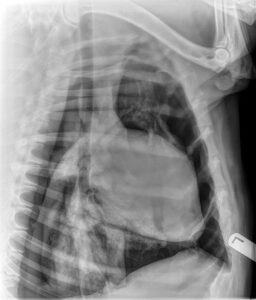
Learn more about pneumothorax in dogs.
When a pneumothorax occurs, atmospheric air enters the pleural cavity from trauma due to other animals, car accidents, puncturing wounds, or spontaneously. Unfortunately, these circumstances can impact one or both lungs. The condition might be fatal if not successfully treated. Continue reading to learn more about pneumothorax in dogs.
What is Pneumothorax?
Pneumothorax is the abnormal air accumulation outside the lungs but within the chest wall. The presence of air prevents the lungs from inflating normally, leading to lung collapse. This condition is crucial and requires immediate medical intervention.
Causes – Spontaneous vs Traumatic
The causes of traumatic pneumothorax in dogs can vary and include:
- Blunt trauma such as being hit by a car
- Chest injuries like impalement with something such as a stick
- Surgical incision into the chest
- Trauma to the trachea
- Lung disease
- Foreign body migration
In a spontaneous pneumothorax, air comes out of the lungs or the massive air passages, gathering in the chest space exterior of the lungs in the absence of any trauma. Spontaneous pneumothorax is primarily common in big, deep-chested dogs, such as a Siberian Husky.
With a traumatic pneumothorax in dogs, there is recent evidence of trauma, such as being kicked by a horse. Pneumothorax is most commonly caused by a ruptured bulla, an air-filled space within the lung. It can also be caused by underlying lung diseases like lung cancer, lung abscesses, inflammatory airway disease, heartworm disease, tracheal rupture, severe pneumonia, or lung nodules caused by fungal infection.
Signs of Pneumothorax in Dogs
Dogs with traumatic pneumothorax experience rapid or difficulty breathing and might be in respiratory distress. They might also have pale or bluish mucous membranes, are in shock, and might have air trapped under the skin. Even though the cause of spontaneous pneumothorax is different, the symptoms are similar to those of traumatic pneumothorax.
Diagnosis
If your dog is experiencing difficulty breathing, he or she needs immediate emergency treatment. If pneumothorax is suspected, x-rays, and chest ultrasounds can demonstrate the presence of free air and might aid in a diagnosis. In the absence of trauma, further examination may help discern the cause of the air accumulation, including roundworm testing, heartworm antigen testing, fecal examination, and blood samples.
Treatment
Most canines require hospitalization with intensive care until the air accumulation within the animal’s chest cavity has stopped or stabilized. If the dog displays respiratory distress, then a portion of the treatment involves extracting the air inside the chest cavity to allow the expansion of the lungs. In addition, your vet may use a chest tube to continuously remove the air accumulating in your dog’s chest cavity. Lastly, oxygen therapy is given until the dog is stable. Once your dog is stabilized, the underlying cause of the pneumothorax can be addressed. Depending on the cause, stabilization may be the only treatment required. Many dogs, however, need surgery to correct the injury to the chest wall. Some even require a lobectomy if the lung lobe is too damaged or diseased.
HERE AT MOUNT CARMEL ANIMAL HOSPITAL, WE’LL TREAT YOUR PETS LIKE FAMILY!
Mount Carmel Animal Hospital has been serving the Northern Baltimore/Southern York community for over 30 years and is proud to be an independently operated, small animal practice committed to excellence in veterinary medicine and client service. From grooming to wellness services, along with Canine Life Skills Training Courses, and surgical procedures, we have the expertise that will best serve the needs of you and your pet. Contact us at 410-343-0200 and follow us on Facebook
